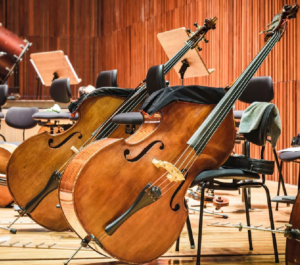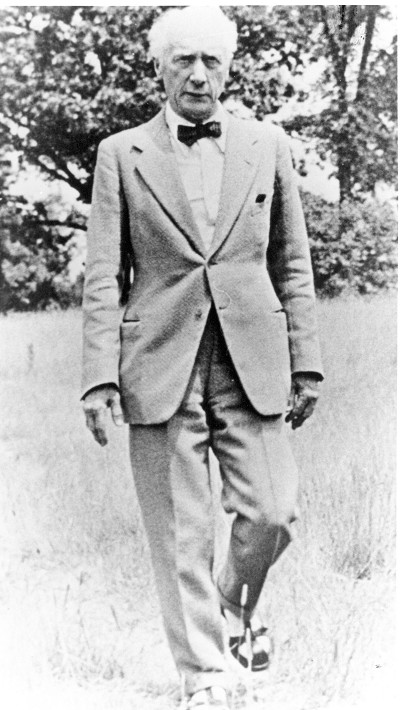F.M. Alexander
(1869–1955)
As a young actor and reciter, Alexander developed hoarseness when performing. As he sought a solution to this problem, he made an important and innovative discovery about the unity of mind and body at a time when science was just beginning to explore that possibility. When he moved from Australia to London in 1904, he began teaching his work to a much wider clientele. Among his students were George Bernard Shaw, John Dewey, and Aldous Huxley.
The Alexander Technique can help you do whatever it is you do with less pain and tension, greater ease and flexibility of mind and body. With practice, under the guidance of the teacher’s gentle, non-manipulative touch and verbal instruction or even online without touch, you can learn to stop interfering with your natural coordination of body and mind. Your movement becomes freer, your senses more acute, and you are thinking clearer and more creatively. You become an embodied presence.
People from all walks of life have found Alexander’s work to be beneficial, often in delightfully surprising ways! In my classes at the Blair School of Music (Vanderbilt University) here in Nashville, I not only teach the Alexander Technique to musicians but also to athletes, actors, dancers, and students from the general population, all of whom are computer users, backpack carriers, and who suffer from the stress of being in a high-pressure environment.
For more details on ways the Technique can help you, click on the following topics:
Breathing Well
Breath is fundamental to life, yet we often unknowingly interfere with this basic life process.
Spiritual disciplines and “body awareness” practices often incorporate breathing instruction in order to facilitate altered states or mindfulness or for some other goal.
In the realm of neuroscience research, Stephen Porges, M.D. and his team have discovered that breath is the basic way we regulate our nervous system toward safety and away from the anxiety and fear associated with unresolved trauma.
Musicians who sing or play a wind or brass instrument often are given instructions on how to breathe most effectively for their given instrument, yet these instructions can run counter to our natural breathing process.
As a voice student and teacher, I struggled with what the term “breath support” really meant for many years before discovering through my study of the Alexander Technique and body mapping how the breath could support my singing without increasing the tension in my torso, legs, jaw, and chest. As a result, I teach “breath support” for speaking, singing, or playing an instrument—or simply supporting life!— through lessons in the Alexander Technique.
The result is often not only an astonishing decrease in body mind stress and tension, but also an increase in skill at whatever you do.
Posture/Poise
Many people come to the Alexander Technique because they want to improve their posture. How we move, stand, and sit are important ways we communicate to others. What our bodies are saying is often unconscious, and when brought to our attention, sometimes even embarrassing!
Just as importantly, poor posture can cause pain, and if it becomes a long-held habit, it can even cause injury. Headaches and TMJ problems are common results from the compression of the neck that characterizes poor postural habits. Many have found their way out of these agonizing conditions by studying the Alexander Technique.
Unlike most approaches to the question of posture, the Alexander Technique does not address posture in terms of finding a particular position and then holding it. To work this way violates the principle that we are made for movement, and that rather than being static, posture is very dynamic. It alters slightly with every breath.
I think the word “poise” more clearly defines what we are after when we ask for better posture, and poise is the result of a bodymind that is allowed freedom to organize us for optimum function. The Alexander Technique gives us ways to clear our thinking of old and outdated ideas, and that frees our bodies to seek ways of functioning optimally in any given situation. Then our ability to be upright without undue tension is a beautiful result!
Muscle and Joint Pain
If you perform repetitive movements for long periods of time—such as using the computer, practicing and playing a musical instrument or sport—you may suffer from chronic or acute muscle and joint pain. Certainly back pain is one of the great causes of suffering, and one that medical science has found difficult to treat.
The Alexander Technique has been proven to help in such situations even when short-term relief through anti-inflammatory drugs and treatments such as icing and stretching have proven ineffective in the long run. This is because the Technique treats us as a bodymind unity, not as a machine with separate parts. What we are thinking is just as important as how we are moving because they are not separate. We can change our thinking and moving to allow our body minds to balance and free for best results. More information on the topic of the Alexander Technique and pain relief is available on this site: www.minncat.org/evidence.html
 I struggled with tendonitis in my wrists for years as a result of over practicing my instrument. The Alexander Technique, and Sally have helped me overcome the pain and allowed me to play my instrument in comfort again. Sally goes at your speed and directly targets what needs to be addressed in each lesson. You will leave feeling refreshed and with a set of tools to keep you practicing the technique at home.
I struggled with tendonitis in my wrists for years as a result of over practicing my instrument. The Alexander Technique, and Sally have helped me overcome the pain and allowed me to play my instrument in comfort again. Sally goes at your speed and directly targets what needs to be addressed in each lesson. You will leave feeling refreshed and with a set of tools to keep you practicing the technique at home.
- Zak, Nashville guitarist
Stress Relief
Habits of thinking and moving -- most of which we are not aware of-- cause undue stress and anxiety.
This stress is often expressed as muscular tension and is often the hidden cause of chronic pain; Stress can also keep us from realizing our potential in a given activity.
Much stress is caused by not being present with our Selves—particularly our physical selves, our bodies—while in activity, as F.M. Alexander put it. The moment we are engaged in some activity like using the computer, making music, playing a game, or anything else we do during the day, we completely lose awareness of HOW we are doing it—of what is happening in our bodymind as we perform this task. Our focus is completely on the outcome. Alexander called that “endgaining.”
In contrast, the Alexander Technique approaches the problem of how to stay present in the moment by the process of observation, inhibition, and direction. With a teacher’s guidance, we observe habitual patterns of tension in the body as we perform simple, daily tasks like sitting, standing, walking. We then give a series of new commands (direction) while not doing the old pattern (inhibition).
As we practice thinking in activity in this way, we use so much less effort that the action seems to arise by itself. Our minds are calmer because they are paying attention to the activity at hand and not adding unnecessary fear to the process. We have come into the present moment.
The result is a freer, more flexible bodymind, and this includes thought patterns and beliefs as well as muscles and movement.
Performance Anxiety
In addition to everyday stress, there are some situations which increase the level of stress and anxiety. Public performance is one of them.
In public performance, whether it be speaking, singing, dancing, acting, playing an instrument, or even engaging in sports activities, everything is heightened . . . for good or for ill!
We love it when the heightened effect enables us to do more than we thought possible. On the other hand, we hate it when the same heightened effect causes us to fail in some way, and to feel foolish in front of others.
It is common to feel heightened anxiety when approaching a performance, and occasionally even “stage fright,” as we call it, occurs. Then the sweaty palms, faster heartbeat, shallow breathing, and trembling muscles get in the way of a satisfying performance. Sometimes we are even paralyzed with fear and end up with a “deer-in-the-headlights” look that communicates our fear to the audience and makes them uncomfortable as well. We might even “freeze” in the midst of performance, a most embarrassing occurrence!
The sources of performance anxiety are many, but there are a few categories into which they fit:
- We may have physical habits that prevent us from moving freely. This reduces the level of skill necessary for performing at our best.
- We may have memories of other times when being in front of others caused humiliation and emotional distress. These, too, are held in the body, and cause stiffness and rigidity instead of flexibility and flow.
- We may be trying to meet certain expectations or standards. These may come from others or from our “internalized others.”
With practice, you can use Alexandrian thinking to lessen performance anxiety. Your performance then acquires the poise and presence that enables an audience to connect with you in a much more profound way. When we realize that to be beautiful, a performance need not be perfect, much of the anxiety from unrealistic expectations flows away.
Moving to the Next Level of Mastery
When you have some activity you are passionate about and you want to get better at it—like making music or playing a sport— often more instruction in the specific activity doesn’t help you improve. Even more practice doesn’t seem to help. Something is blocking your progress.
When stuck at a particular level of mastery, we often think we need more of something—more instruction, more practice, more talent or strength—when what we really need is less of something—less getting in our own way through old habits of thinking and moving. Learn how to stop getting in your own way, thus clearing the path to the next level of mastery.
I work with you both away from and while engaged in your chosen activity. Specific habits of moving and thinking then are addressed, resulting in greater joy and productivity.
Whether at a beginning or an advanced level, you can improve at what you do. The Alexander Technique is especially transformative in this regard.
I would say that having an Alexander lesson with you on my bass is just as helpful and useful, if not more enlightening, than any lesson I’ve had with professional players and teachers I’ve studied with, especially at this point in my career.
I feel that studying the Alexander Technique with you is essential to advancing my playing and musicianship to the next level. This study helps me to bring awareness into my playing and what I’m trying to communicate, and to do it in the most effortless way.
I would also say that this study helps me move through everyday life with more awareness and ease.
—Kristen B. (The Minnesota Orchestra)

Finding Your Voice
Explore the voice as a metaphor for self-discovery and self-expression. Learn to incorporate whole-self awareness into your speaking and singing. Experience greater ease, confidence, and expression in performance and in daily life.
It is in the context of the whole person that I offer voice study for singers, actors, and speakers. Diction, projection, resonance, tone quality and issues of performance anxiety are addressed in lessons that are usually 45 or 60 minutes long. This study includes basic instruction in bodymapping and the Alexander Technique.
Sally's work with me has really had an amazing impact on my singing. My new awareness of where my shoulders are helped. My voice teacher and I discovered that at the last minute of breath intake, I was pulling my shoulders back like a little soldier — as if that was going to help me take in more air. Now I don't have to struggle to take in breath, and the Fauré I just performed got rave reviews.
—J. Austin (CMO, Vanderbilt Medical Center Communications/singer)
